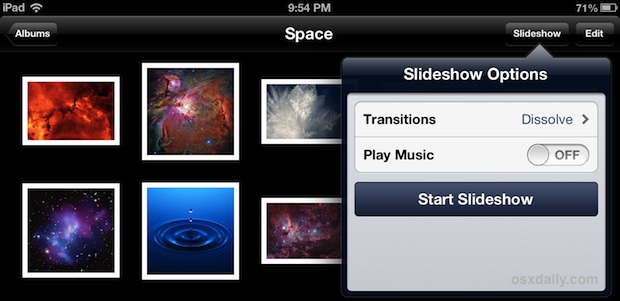Use a Single External Hard Drive for Time Machine Backups and File Storage
 Having regular backups of your Mac is a necessity, and there is really no easier way to consistently back up your Mac than by using the excellent Time Machine feature of OS X. But with the enormous size of external hard drives and their prices becoming cheaper and cheaper, it’s not always necessary to dedicate an entire gigantic hard disk just for Time Machine backups, particularly if your Mac has a smaller hard drive and thus the backups won’t take up that much space in general. For these situations, configuring the single external hard disk to have dual use is an excellent choice. The end result will be an external storage drive split into two partitions, one to be setup exclusively for Time Machine backups, and another partition intended for typical file system access and file storage.
Having regular backups of your Mac is a necessity, and there is really no easier way to consistently back up your Mac than by using the excellent Time Machine feature of OS X. But with the enormous size of external hard drives and their prices becoming cheaper and cheaper, it’s not always necessary to dedicate an entire gigantic hard disk just for Time Machine backups, particularly if your Mac has a smaller hard drive and thus the backups won’t take up that much space in general. For these situations, configuring the single external hard disk to have dual use is an excellent choice. The end result will be an external storage drive split into two partitions, one to be setup exclusively for Time Machine backups, and another partition intended for typical file system access and file storage.
Read more »






 The iPad and iPhone don’t freeze or crash often, but when they do it can be an epic freeze-up, where the device can either get stuck in an app or, worse, it gets frozen on the dreaded iOS “spinning wheel of death”, the little wait cursor that never goes away. Left on it’s own in that state, that spinning wheel can quite literally spin forever until the battery drains and the device dies out, but that’s obviously not a solution to resolve the rare major iOS crashes. We’ll cover three tricks to fix major iOS crashes, the first will attempt to just exit out of the crashing application, the next will forcibly restart the device, and finally for the worst scenarios, we’ll restore iOS as new, though that really should be a last resort that is rarely applicable to most situations.
The iPad and iPhone don’t freeze or crash often, but when they do it can be an epic freeze-up, where the device can either get stuck in an app or, worse, it gets frozen on the dreaded iOS “spinning wheel of death”, the little wait cursor that never goes away. Left on it’s own in that state, that spinning wheel can quite literally spin forever until the battery drains and the device dies out, but that’s obviously not a solution to resolve the rare major iOS crashes. We’ll cover three tricks to fix major iOS crashes, the first will attempt to just exit out of the crashing application, the next will forcibly restart the device, and finally for the worst scenarios, we’ll restore iOS as new, though that really should be a last resort that is rarely applicable to most situations. If you’re a heavy command line user, you’re probably well aware that the arrow keys can be used to flip through previously executed commands and the tab key can complete them. But both of these functions can be significantly improved upon for searching through past command history by adding a few modifications to your .inputrc file.
If you’re a heavy command line user, you’re probably well aware that the arrow keys can be used to flip through previously executed commands and the tab key can complete them. But both of these functions can be significantly improved upon for searching through past command history by adding a few modifications to your .inputrc file.

 Many older Macs lost out on the ability to run OS X Mountain Lion (10.8.3!), but some hard working fellows have created a free third party tool called MLPostFactor that allows for the newest version of OS X to be installed on older, officially unsupported Macs. The process used to be quite
Many older Macs lost out on the ability to run OS X Mountain Lion (10.8.3!), but some hard working fellows have created a free third party tool called MLPostFactor that allows for the newest version of OS X to be installed on older, officially unsupported Macs. The process used to be quite 